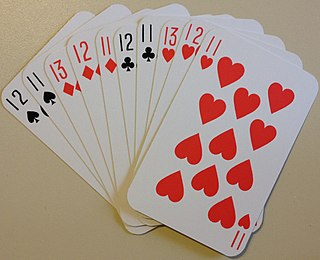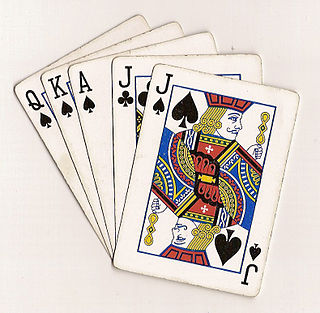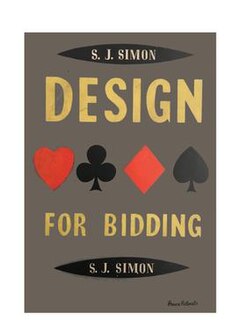Related Research Articles

Contract bridge, or simply bridge, is a trick-taking card game using a standard 52-card deck. In its basic format, it is played by four players in two competing partnerships, with partners sitting opposite each other around a table. Millions of people play bridge worldwide in clubs, tournaments, online and with friends at home, making it one of the world's most popular card games, particularly among seniors. The World Bridge Federation (WBF) is the governing body for international competitive bridge, with numerous other bodies governing bridge at the regional level.

500 or five hundred, also called bid Euchre is a trick-taking game that is an extension of euchre with some ideas from bridge. For two to six players, it is most commonly played by four players in partnerships, but is sometimes recommended as a good three-player game. It arose in America before 1900 and was promoted by the United States Playing Card Company, which copyrighted and marketed the rules in 1904. 500 is a social card game and was highly popular in the United States until around 1920 when first auction bridge and then contract bridge drove it from favour. 500 continues to enjoy popularity in Ohio and Pennsylvania, where it has been taught through six generations community-wide, and in other countries: Australia, New Zealand, Canada (Quebec) and Shetland. The originator of Five Hundred, US Playing Card Company of Cincinnati, Ohio, now has headquarters across the Ohio River in Erlanger, Kentucky. Five hundred is promoted by some as the national card game of Australia.
Acol is the bridge bidding system that, according to The Official Encyclopedia of Bridge, is "standard in British tournament play and widely used in other parts of the world". It is a natural system using four-card majors and, most commonly, a weak no trump.
In contract bridge, the Law of total tricks is a guideline used to help determine how high to bid in a competitive auction. It is not really a law but a method of hand evaluation which describes a relationship that seems to exist somewhat regularly. Written by Jean-René Vernes for French players in the 1950s as a rule of thumb, it was first described in English in 1966 International Bridge Academy Annals. It received more notice from appearing in The Bridge World in June 1969. In 1981 Dick Payne and Joe Amsbury, using their abbreviation TNT, wrote at length about it for British readers. Later, in the US, Marty Bergen and Larry Cohen popularized the approach, using their preferred abbreviation: 'the LAW'.
In the card game of bridge, the unusual notrump is a conventional overcall showing a two-suited hand. It was originally devised by Al Roth in 1948 with Tobias Stone, to show the minor suits after the opponents opened in a major.
Calls made during the auction phase of a contract bridge game convey information about the player's card holdings. Calls may be "natural" or "artificial". A bridge convention is an agreement about an artificial call or a set of related artificial calls.
Psychic bid is a bid in contract bridge that grossly misstates the power and/or suit lengths of one's hand. It is used deliberately to deceive the opponents. Normally, the psychic bid is made with a weak hand, overstating its overall strength, the length and strength in a particular suit, or both.
The Michaels cuebid is a conventional bid used in the card game contract bridge. First devised by Michael Michaels of Miami Beach, FL, it is an overcaller's cuebid in opponent's opening suit and is normally used to show a two-suited hand with at least five cards in each suit and eight or more points.

Bid Euchre, Auction Euchre, Pepper or Hasenpfeffer, is the name given to a group of card games played in North America based on the game Euchre. It introduces an element of bidding in which the trump suit is decided by which player can bid to take the most tricks. The primary differences are the number of cards dealt, absence of any undealt cards, the bidding and scoring process, and the addition of a no trump declaration. It is typically a partnership game for four players, played with a 24, 32 or 36-card pack, or even two decks of 24 cards each. It should not be confused with another game also called Bid Euchre q.v. Five Hundred.
A bidding system in contract bridge is the set of agreements and understandings assigned to calls and sequences of calls used by a partnership, and includes a full description of the meaning of each treatment and convention. The purpose of bidding is for each partnership to ascertain which contract, whether made or defeated and whether bid by them or by their opponents, would give the partnership their best scoring result.
Preempt is a bid in contract bridge whose primary objectives are (1) to thwart opponents' ability to bid to their best contract, with some safety, and (2) to fully describe one's hand to one's partner in a single bid. A preemptive bid is usually made by jumping, i.e. skipping one or more bidding levels. Since it deprives the opponents of the bidding space, it is expected that they will either find a wrong contract of their own, or fail to find any. A preemptive bid often has the aim of a save, where a partnership bids a contract knowing it cannot be made, but assumes that, the penalty will still be smaller than the value of opponents' bid and made contract.
These terms are used in contract bridge, using duplicate or rubber scoring. Some of them are also used in whist, bid whist, the obsolete game auction bridge, and other trick-taking games. This glossary supplements the Glossary of card game terms.
In the card game contract bridge, a takeout double is a low-level conventional call of "Double" over an opponent's bid as a request for partner to bid his best of the unbid suits. The most common takeout double is after an opponent's opening bid of one of a suit where the double shows a hand with opening values, support for all three unbid suits and shortness in the suit doubled. Normally, the partner of the doubler must bid his best suit but may pass if (a) his right hand opponent intervenes or (b) on the more rare occasions when his hand is such that he wishes to convert the takeout double to a penalty double.
In contract bridge, various bidding systems have been devised to enable partners to describe their hands to each other so that they may reach the optimum contract. Key to this process is that players evaluate and re-evaluate the trick-taking potential of their hands as the auction proceeds and additional information about partner's hand and the opponent's hands becomes available.
In contract bridge, an overcall is a bid made after an opening bid has been made by an opponent; the term refers only to the first such bid. A direct overcall is such a bid made by the player seated immediately to the left of the opener, i.e. next in the bidding rotation; an overcall in the 'last seat', i.e. by the player to the right of opener, which is made after two intervening passes, is referred to as a balancing overcall.
Rusinow leads is a bridge convention used as part of defensive carding. Rusinow leads are commonly used only on the opening lead against a suit contract; nevertheless, some experts use Rusinow leads only against notrump.
Bridge base basic, also known as BBO basic, is a bidding system for the game of bridge based on the Standard American Yellow Card (SAYC). It is simplified, suitable for beginners, and widely used in internet bridge, particularly on Bridge Base Online. It is taught in Fred Gitelman's educational software called Learn to Play Bridge that is available as a free download from the American Contract Bridge League's website.
Shooting is an approach in bridge to the bidding or play of a hand which aims for a favorable result by making a choice that is slightly against the odds. A player might decide to shoot toward the end of a pairs game, when he judges that he needs tops to win, not just average-plus results.
Theodore Alexander "Teddy" Lightner was an American bridge player. He developed the Lightner double, a bridge bidding convention.

Design for Bidding is a book by the Russian-born English bridge player S. J. "Skid" Simon, published posthumously in 1949. It is about the theory of bidding in contract bridge, particularly in the context of the Acol system of which Simon was one of the co-developers. It was the first, and as of 2015, remains one of the few, studies of the thought processes involved in designing a bidding system, rather than simply setting out the author's conclusions.
References
- ↑ Manley, Brent; Horton, Mark; Greenberg-Yarbro, Tracey; Rigal, Barry, eds. (2011). The Official Encyclopedia of Bridge (7th ed.). Horn Lake, MS: American Contract Bridge League. p. 296. ISBN 978-0-939460-99-1.
- ↑ Simon, S. J. (1945). Why You Lose at Bridge. London: Nicholson & Watson. p. 15. OCLC 18352804.